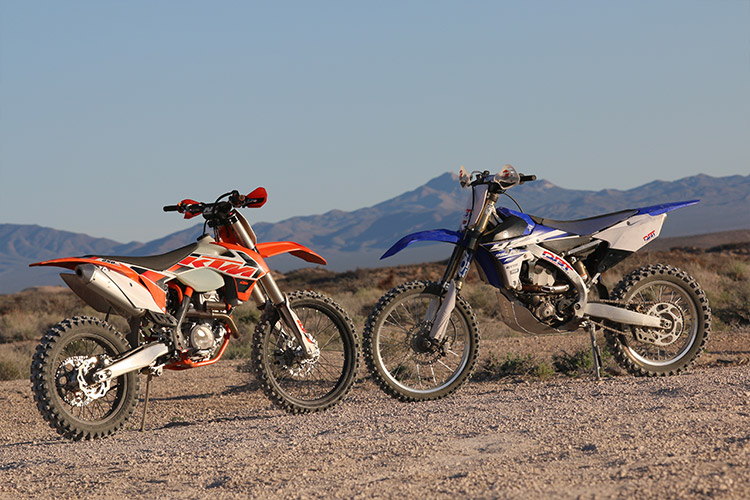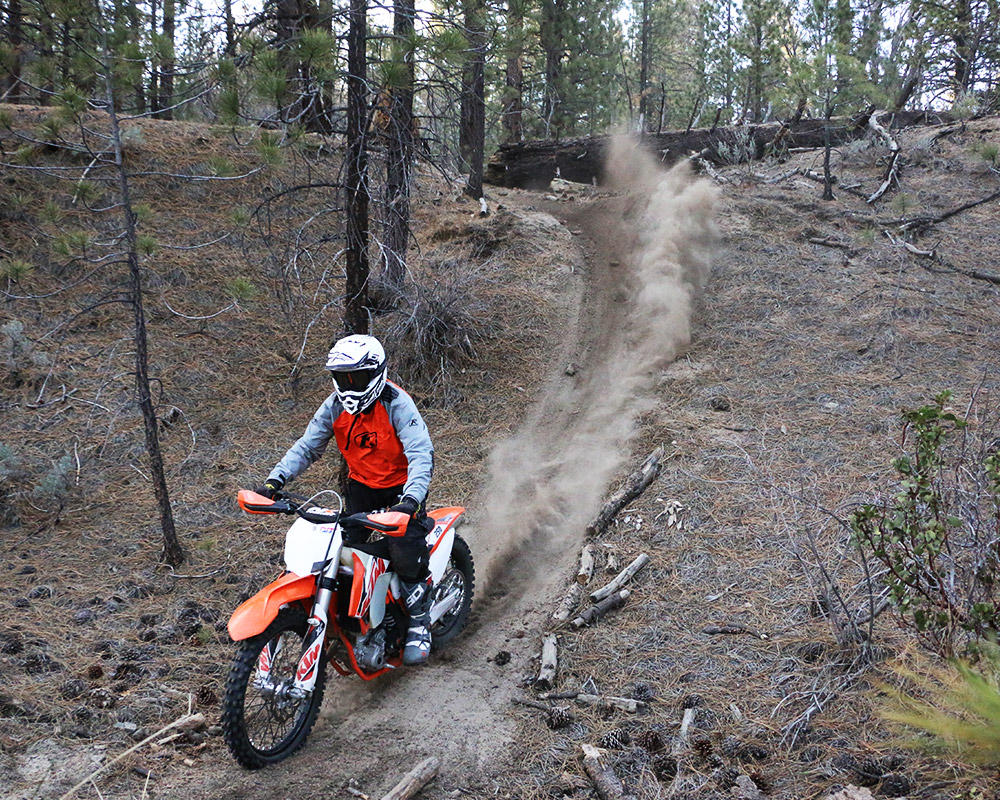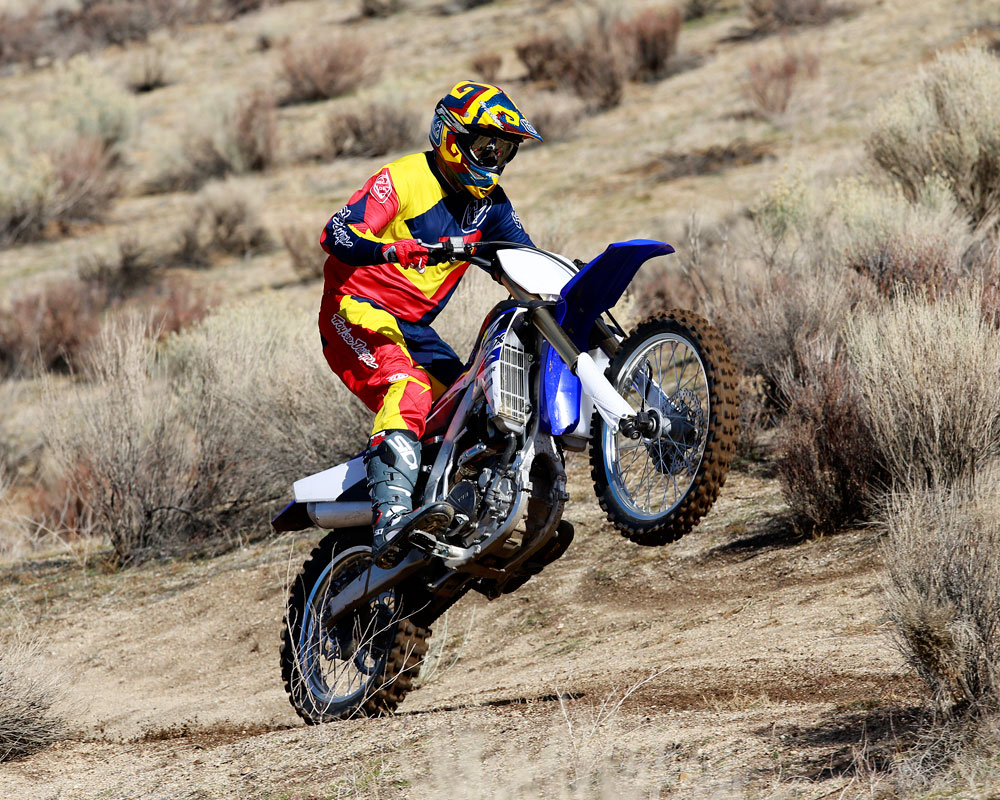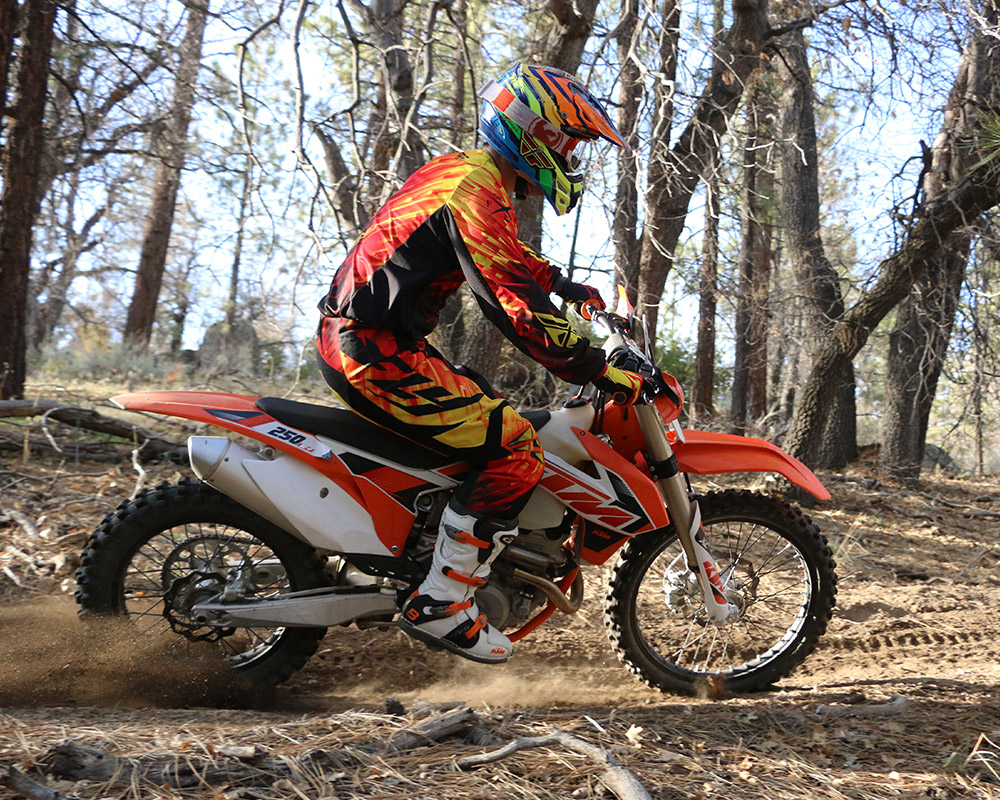 If you like to ride and race off-road and motocross both, there have been plenty of options for you to go and build the perfect do-all bike. But KTM has typically had the bike you were trying to build in the XC line. A bike that is based off the pure motocross machine and equipped with the essentials to make it into a minimalist off-roader and nothing more. Not new to the game but revived and more focused, Yamaha is again taking a stab at the competition off-road segment with its YZ250FX, the first race bike since the two-stroke WR days. So after a lot of time on both bikes, here is what you need to know about them if you are undecided.
If you like to ride and race off-road and motocross both, there have been plenty of options for you to go and build the perfect do-all bike. But KTM has typically had the bike you were trying to build in the XC line. A bike that is based off the pure motocross machine and equipped with the essentials to make it into a minimalist off-roader and nothing more. Not new to the game but revived and more focused, Yamaha is again taking a stab at the competition off-road segment with its YZ250FX, the first race bike since the two-stroke WR days. So after a lot of time on both bikes, here is what you need to know about them if you are undecided.
-Both of these bikes are excellent performers out of the box. Each is ready to race as much as can be expected from a bike built for a large variety of riders and an even bigger scope of usability. For sure each has some distinct characteristics and things that are different. Knowing and understanding those traits will determine which is better or worse—for you.
 -The two areas where these bikes really differ are in the power delivery and the feeling of the machine’s size. The KTM puts out more power on a dyno but both bikes are pretty much identical in any kind of comparative test in the real world. The Yamaha feels smaller and more compact, sometimes lighter when riding it. We’ll detail this out for you.
-The two areas where these bikes really differ are in the power delivery and the feeling of the machine’s size. The KTM puts out more power on a dyno but both bikes are pretty much identical in any kind of comparative test in the real world. The Yamaha feels smaller and more compact, sometimes lighter when riding it. We’ll detail this out for you.
-The KTM has a longer powerband. Both bikes start pulling at about the same RPM but the KTM revs longer and does not rev as quick in the upper tier of its pull using that portion of the curve better. There is less of a sign-off from the KTM where the Yamaha clearly tells you it is time to shift just a little bit earlier. The KTM is smoother and feels slower. The KTM also stalls a little easier and feels like it has less flywheel effect when chugging.
-The Yamaha feels faster and there are some steps in the powerband, especially off the bottom and into the mid where the YZ feels spunkier and more aggressive. The YZ will pick-up easier with just the throttle and spin up quicker through the RPM range. You end up shifting earlier on the Yamaha and using the clutch a little more on the KTM to boost the power if you ride in the lower RPMs. The KTM has better clutch feel as well, it is more solid and a more aggressive bite, yet those sloppy on the lever might prefer the Yamaha’s softer engagement.
-Both companies offer the ability to adjust the ECU settings through a tuner package. The simple Yamaha GYTR Tuner is very quick and effective. We have not used the KTM Tuning tool but plan to in the future with an understanding that is is a lot more complex and requires the use of a computer.
 -The YZFX is more compact feeling as long as you don’t look down. Look at the radiator shrouds and where the gas cap usually is and you’ll get confused as it looks kind of wide. The KTM has a more roomy layout. Both are adjustable through the handlebar position but taller riders always preferred the KTM. On the scale the bikes are identical with a full tank of gas but the KTM is carrying an extra half-gallon.
-The YZFX is more compact feeling as long as you don’t look down. Look at the radiator shrouds and where the gas cap usually is and you’ll get confused as it looks kind of wide. The KTM has a more roomy layout. Both are adjustable through the handlebar position but taller riders always preferred the KTM. On the scale the bikes are identical with a full tank of gas but the KTM is carrying an extra half-gallon.
-Both bikes feel very light and agile, like most 250Fs do. The KTM feels a bit heavier in side-to-side movements where the Yamaha is a little heavier through the handlebars. Neither is in any way bad here, that is just the small variance. The most notable difference is that the KTM has a more neutral handling bike and can easily be set up to ride or turn on either the front or the rear wheel. The YZ really likes turning on the front wheel and does not like sliding the back end out as much. It is almost as if the rear of the YZ is constantly planted, some prefer this, for others it is a bother.
-The KTM is a bit more stable feeling and does not transition into a setup that encourages headshake as easily as the Yamaha does. Get either of these bikes set up too high in the rear (too much weight on the front wheel) and they will both headshake, but set up properly they are both fine.
 -In the suspension department both companies have nailed down a great all-around standard setup for racing GP or GNCC-style races. But we can get particular. The KTM has a stiffer and heavier sprung nature, we’d estimate it was set up for a 170-180 lb. rider where the Yamaha seems more set up for a 160 lb. rider stock. The adjustability of the KTM, specifically the WP 4CS fork is not typical and losing that stiff feeling (or changing any low-speed compression or rebound feeling) isn’t as easy or common feeling as it is on the Yamaha. To put it simply the Yamaha is more comfortable while both bike’s suspension do an excellent job for what they were intended.
-In the suspension department both companies have nailed down a great all-around standard setup for racing GP or GNCC-style races. But we can get particular. The KTM has a stiffer and heavier sprung nature, we’d estimate it was set up for a 170-180 lb. rider where the Yamaha seems more set up for a 160 lb. rider stock. The adjustability of the KTM, specifically the WP 4CS fork is not typical and losing that stiff feeling (or changing any low-speed compression or rebound feeling) isn’t as easy or common feeling as it is on the Yamaha. To put it simply the Yamaha is more comfortable while both bike’s suspension do an excellent job for what they were intended.
-If you venture onto a motocross track, we found the KTM can get away with faster riders and more aggressive jump laden tracks. The XC holds itself up better in the stroke especially on steeper jump faces. This is what really separates these bike’s performance from the pure MX cousins they are derived from. You can use the clickers on the Yamaha to achieve a more motocross setup but it will become very uncomfortable off-road while still using too much stroke on the jumps. Both have decent bottoming resistance (the KTM being stiffer was a tad better).
-Trail riding or choppy technical off-road (roots and rocks) is where the Yamaha shines in comparison to the KTM. Standard it is set up better for this and it is much easier and compliant when adjusted for it.
-The KTM is a lot easier and quicker to do the basic maintenance, even though both are pretty simple. Having a conventional gas tank location it is easier to fuel the KTM in a race and both get very similar gas mileage, the XC will go further since it carries more.
-Some may view the lack of a kickstart on the KTM as an issue but in reality we never used the one on the Yamaha except to see how it worked. If you can’t keep a battery charged and know when to replace it, you should have bigger worries about how well you are at changing the engine oil and cleaning an air filter.
 -All of the little details on the bikes, from fitting of plastic to the controls is top-notch on either machine. The KTM’s brake (especially) and clutch adjustability are easier and the hydraulic clutch feel is a bonus. The KTM comes standard with handguards. We feel the durability of both bikes is similar and on the higher end compared to all brands which should be a consideration on a racing 250F. The KTM also has more powerful brakes.
-All of the little details on the bikes, from fitting of plastic to the controls is top-notch on either machine. The KTM’s brake (especially) and clutch adjustability are easier and the hydraulic clutch feel is a bonus. The KTM comes standard with handguards. We feel the durability of both bikes is similar and on the higher end compared to all brands which should be a consideration on a racing 250F. The KTM also has more powerful brakes.
To pick a winner between these two bikes is like telling you what flavor of ice cream is better. It all depends on personal taste and knowing what you are looking for. Your dealer, the type of racing or contingency program, the availability of parts are all additional concerns above and beyond the strict performance of the machine. If we were to make some blanket recommendations we’d advice the following . Smaller and lighter riders favored the Yamaha, heavier and taller the KTM. The more motocross you are doing, the KTM was a better choice (unless you are smaller and especially lighter). Currently there is more aftermarket support for the KTM but parts for the Yamaha are coming quick. And in the real picture, neither of these bikes is standing in the way, performance wise, of you winning or having a good time riding.

